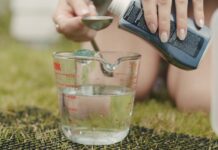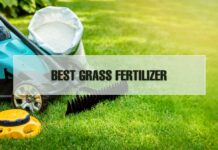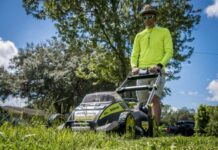
Sprayers that stick to the end of a hose are valuable resources that every gardener should consider purchasing. You’ve come to the right place if you’ve been considering getting one but aren’t sure if you need one. All you need to know about using a hose-end sprayer is right here.
What is a Hose-end Sprayer?
Hose end sprayers are a quick and easy way to combine and apply weed killers and fertilizers. As it passes through the nozzle, the sprayer pulls the liquid treatment from the bottle and mixes it with water.
Fixed-rate, adjustable-flow, and ready-to-use hose-end sprayers are the three models to be aware of.
1. Fixed-Rate
Fixed-rate sprayers do just as they say on the tin. At a set pace, they siphon liquid from the bottle and through the nozzle. To ensure the proper distribution rate, you must mix the proper concentration beforehand and apply it to the container with this form of the sprayer.
2. Adjustable Flow
Adjustable-flow sprayers have a dial that lets you control how quickly the liquid exits the bottle. You don’t have to think about mixing something before using various concentrations.
3. Ready to Use
Some fertilizer and pest-control companies sell ready-to-use hose-end sprayers. They are usually pre-set to mount to a standard garden hose and spray at a pre-set rate and contain the brand’s liquid formula. These sprayers are single-use only and can only be used with the product that comes with them.
Despite the fact that these forms are very similar, there are some minor variations in how they are used. We’ll start with the adjustable flow because, while not difficult, it’s the most difficult of the three.
Also, See Garden Hose Repair Kit – Why You Should Consider Buying a Hose Repair Kit?
How to Use an Adjustable Flow Hose-End Sprayer
Put on rubber gloves and eye protection before using any kind of chemical spray or hose-end sprayer.
The next move is to pour the condensed liquid into the sprayer’s container. It normally unscrews with relative ease. Then, into the bottle, pour an undiluted concentrated. Follow the instructions to determine how much you’ll need to cover the region you’d like to handle.
Many sprayer bottles have side markings to help you fill them in the proper amount. If you want to be as accurate as possible, you can also use a measuring cup. If you just need to cover a small area, a measuring spoon will be preferable. Screw the bottle back into place after you’ve added the appropriate amount of concentrate.
Change the dial after that. The application rate should be noted on the side of the concentrate bottle you’re using once again. The dial’s position can differ from one sprayer to the next, but they’re typically fairly easy to operate.
All you have to do on most models is turn the dial until the indicator points to the number of gallons you want to spray.
Also, See How to Install, Use, and Harvest a Rain Barrel for Beginners
Attach your garden hose to the sprayer next, ensuring that the faucet is switched off. Make sure it’s firmly fastened before turning it on to around 34% of full pressure. To ensure even coverage, turn the nozzle tip to adjust from a mist to a spray.
Engage the handle of your sprayer and apply where appropriate as you walk around your yard or garden. To ensure that you cover everything, it’s best to walk in a fixed pattern. Use less pressure or lower the water spigot pressure if you’re using more concentrate than you expected.
When you’re done, return any remaining concentrate to the bottle and fill the sprayer with water. Spray water through the hose until the bottle is empty by turning the dial to the highest level. This cleans the spray head as well as the bottle.
How to Use a Fixed-Rate Hose-End Sprayer
There are a few main distinctions between using a fixed-rate hose-end sprayer and using an adjustable-rate sprayer.
You must premix the liquid before applying it because you cannot regulate the flow of the liquid leaving the sprayer container. Reading the notes on the packaging of the product you’re using is the safest way to do so.
Fill the bottle with the appropriate amount of water and substance. After that, mount it to the nozzle and give it a strong shake.
Connect the sprayer to the hose and turn the water on, just not all the way, if you haven’t already. When the water starts to come out of the nozzle, open the sprayer valve. To ensure that you get decent, even coverage, walk uniformly around the area while keeping the sprayed.
Close the valve, remove the bottle, and discard any remaining solution when you’re done. You can’t save or reuse the concentrate because you’ve already mixed it with water in the bottle.
Fill the bottle with water, then use the hose and sprayer to clean the bottle and nozzle of any residue.
Also, See 10 Best Backpack Sprayer in 2024 | Buying Guide
How to Use a Ready-to-Use Sprayer
Since each ready-to-use sprayer is a little different, make sure you read the instructions thoroughly. However, they all obey the same protocol in general.
To open the flow, most have a simple switch or knob. The product will need to be added to the bottle, or it may already be there. Turn the hose on and adjust the knob to the mix setting. Walk at a steady pace to ensure that everything is hidden.
Check to see how much liquid is left in the bottle and, if necessary, repeat the application to ensure you’ve used the full amount prescribed.
How Can You Tell How Much Water Is Spraying From A Hose-End Sprayer?
Sprayers that are ready to use have been calibrated and can spray at the correct pace. Fixed-rate sprayers, as the name implies, have a set rate, so you don’t have to think about changing the sprayer itself.
However, if you’ve walked around your lawn or garden and discovered that you didn’t use as much fertilizer or spray as you could have, you’ll need to change your application technique.
You’ll have to experiment with other options because you can’t adjust the pace at which the solution leaves the sprayer. If you have a lot of water left in the bottle, you can increase the water pressure from the hose.
Another option is to walk slower or faster depending on whether more or less of the solution is required.
When it comes to adjustable sprayers, the water from the hose dilutes the concentration, allowing you to control how much is actually coming out of the sprayer.
The application rate is regulated by simple dials on most hose-end sprayers. The dial should be calibrated in ounces or teaspoons and should be marked from 1 to 10.
Also, See The Top 10 Best Broadcast Spreader in 2024 – Buying Guide
Adjust the knob to the correct number after reading the label of the product you’re using and deciding how much you need and the appropriate concentration. Turn the dial to 3 ounces if the knob is in ounces and you’re adding three ounces of concentrate.
Don’t worry if you need to convert from ounces to teaspoons or vice versa; it’s easy. 6 teaspoons are equivalent to one ounce. So, in the previous case, if you were asked to add 18 teaspoons, you would change the dial to 3 since 18 teaspoons equal 3 ounces.
Final Thoughts
As you can see, hose-end sprayers aren’t difficult to use, but they do need some practice. Choose the alternative that best suits your needs, and then get started with this time-saving and useful tool.
Also, See How to Choose the Best Lawn Mower for Your Garden – Buying Guide






